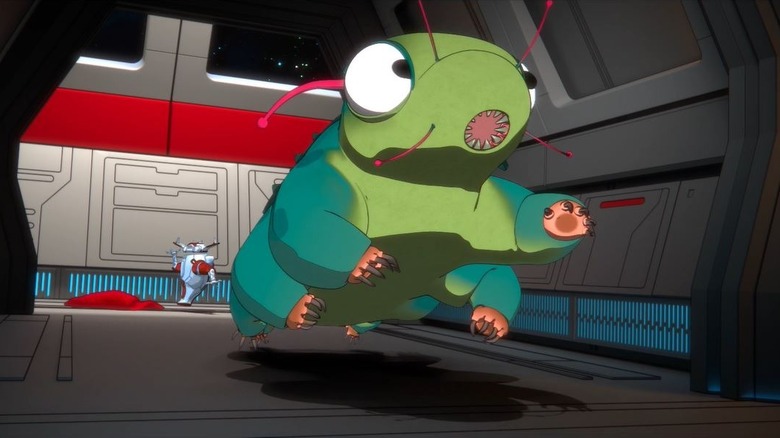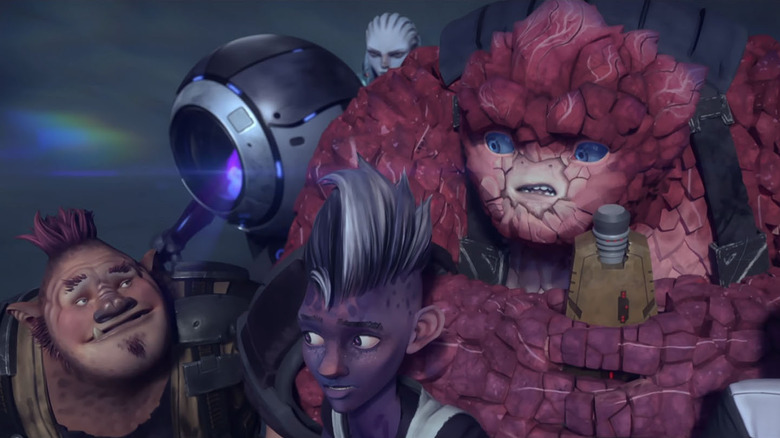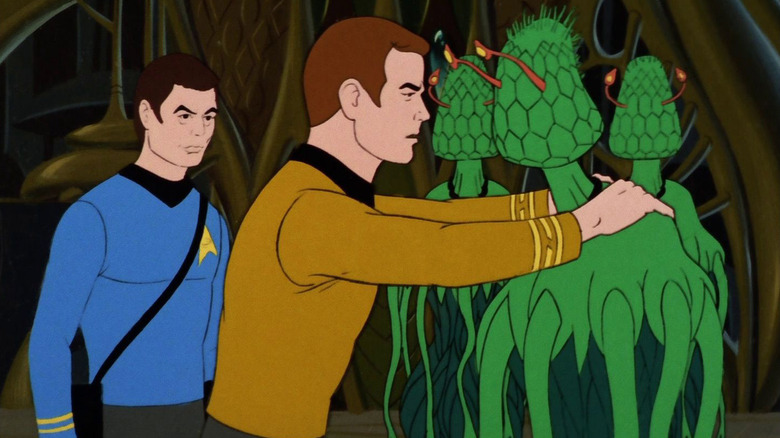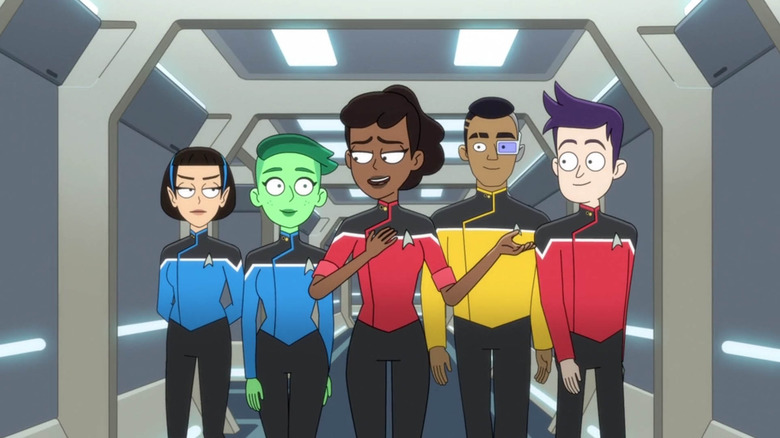All 5 Star Trek Animated Shows, Ranked From Worst To Best
As of this writing, there have been five animated series in the annals of "Star Trek." The first was also called "Star Trek" (although is now better known as "Star Trek: The Animated Series"), and it reassembled most of the 1966 show's original cast (Walter Koenig was left out), continuing where the original series left off. It ran for two seasons in 1973 and 1974. Some Trekkies consider "Animated Series" to be only partially canonical, as later films and shows contradicted what it put forth. It was, however, the first time Trekkies learned that the "T" in "James T. Kirk" stood for "Tiberius."
The second animated "Star Trek" series didn't launch until 2020, after the franchise had moved to Paramount+. "Star Trek: Lower Decks" was a 30-minute animated sitcom version of "Star Trek," set shortly after the events of "Star Trek: Voyager." That show lasted a successful five seasons before coming to a close in 2024. While "Lower Decks" was in production, Paramount also launched "Star Trek: Prodigy," a CGI-animated series produced by Nickelodeon. That show was meant to be more kid-friendly than other "Star Trek" shows, and featured a cast of teenage characters. That show lasted two seasons, spread over 2021 and 2024.
As for the other two animated "Star Trek" shows, there may be some debate as to their taxonomy. The stop-gap anthology series "Short Treks" ran for two seasons from 2018 to 2020, and, as the title implies, was constructed of short, independent stories within the Trek universe. Two of the shorts in the show's second season were animated, so that may count as an animated series unto itself. "Short Treks" then, in turn, gave birth to the all-animated series "Very Short Treks," a new anthology series of brief, crass, non-canonical comedic cartoons. That series ran for five episodes in 2023.
How do these animated shows rank? Let us slip into our judge's robes and make some tough calls.
5. Very Short Treks
The "Very Short Treks" series was created by Casper Kelly, the mastermind behind "Stroker and Hoop," "Too Many Cooks," and the Cheddar Goblin sequence from "Mandy." Kelly clearly has a twisted sense of humor, and handing him "Star Trek" is like handing a handkerchief to a hay fever sufferer and then asking them not to get any mucous on it. Of course, Kelly created one of the silliest — and dumbest — "Star Trek" projects to date, mocking the franchise relentlessly, and doing so with the participation of many of the show's various cast members.
The idea behind "Short Treks" was to pay homage to "Star Trek: The Animated Series," which turned 50 in 2023. Kelly animated all his shorts in the style of "Animated Series," which was produced by Lou Scheimer's famous Filmation studio back in the day. Kelly, however, was clearly not interested in traditional "Star Trek" stories about exploration and diplomacy, nor was he interested in making small character studies of well-known Starfleet characters. Instead, he created aliens with underwear heads. He made a species that considers it polite to wipe boogers on visiting Federation officers. He created a character named Ass Face.
"Star Trek" can certainly stand some irreverence, as its main characters tend to be stuffy, ultra-formal, uniform-wearing diplomats. And goodness knows I love a good booger joke or Ass Face gag. But I don't know what the heck this is. It knows enough about "Star Trek" to make inside jokes, but it also seems to hate the series. One might say that "Very Short Treks" is all in good fun, but that would only be true if it were fun.
4. Short Treks
When "Short Treks" debuted in October 2018, it seemed to have a mercenary function. At the time, the first season of "Star Trek: Discovery" had just come to an end, and its planned second season wouldn't debut until the following January. CBS All Access (not yet named Paramount+) clearly wanted to keep subscribers on the hook until then, so the network seemingly rushed "Short Treks" into production, releasing one short every few weeks, just far apart enough to keep the monthly subscription fees renewing. The shorts were clearly very low-concept, and most of them were filmed on mostly empty "Discovery" sets, usually with only a few actors on hand.
Few of the shorts are standouts, and they didn't get truly creative until later in the show's run. In the second season, "Short Treks" ran its first animated episode, called "Ephraim and Dot," directed by noted composer Michael Giacchino. The short followed the adventures of Ephraim, an outsize spatial tardigrade, as it infiltrated the tiny tunnels in the hull of the U.S.S. Enterprise. It was pursued by a repair drone, Dot, that aimed to eject it. Thanks to a few glimpses through portals, Ephraim was inside the Enterprise during the events of "Star Trek II: The Wrath of Khan" and "Star Trek III: The Search for Spock."
The second animated episode of "Short Treks" was called "The Girl Who Made the Stars," and was directed by Trek regular Olatunde Osunsanmi. This one was about a young Michael Burnham (the main character from "Discovery") listening to an old African folk tale told by her father. It has very little to do with "Star Trek" and is only okay.
Indeed, most of "Short Treks" is only okay. Despite its fitful moments of ambition, it always felt a little mercenary, done for financial reasons instead of creative ones. It never had the thrill of something like "Liquid Television," and never added importantly to Trek canon. You can skip it.
3. Star Trek: Prodigy
The beleaguered "Star Trek: Prodigy" was infamously canceled while its second season was in production, and unceremoniously dropped from Paramount+ altogether. The show was eventually picked up by Netflix, which aired its second season, but many Trekkies wondered why "Prodigy" warranted such harsh treatment. Was it the CGI animation? Was it because it was aired by the kid-friendly Nickelodeon? Was it the elongated story arcs? It's hard to say.
It could have been because "Prodigy" started out in a very non-"Star Trek" place. At the start of the series, the main characters — a group of runaway teenage slaves — had never heard of Starfleet before, and had never encountered a Starfleet vessel. In the first few episodes, though, they find an abandoned ship called the U.S.S. Protostar, board it, and are instructed on how to use it by a hologram of Captain Janeway (Kate Mulgrew) of the U.S.S. Voyager. Despite the "Star Trek" iconography, the villains and action made "Prodigy" feel more like "Star Wars."
Over the course of the series, however, the teen runaways — operating at the behest of the hologram Janeway — began to think of themselves as a crew that had to work together and employ their personal expertise in creative ways. By the end of the first season, they are all in Starfleet back on Earth, happy to have outgrown their dark past. "Star Trek," the show argues, is better than "Star Wars."
The second season was an even more elaborate story about time travel, retrieving the Protostar from villains, and reuniting many old, familiar faces. The show seems shaky at first, but quickly becomes pretty great. It didn't deserve its fate.
2. Star Trek: The Animated Series
If one were particularly daring, one could rank "Star Trek: The Animated Series" even higher than the original "Star Trek" series. Gene Roddenberry oversaw its creation, and many of the original show's writers returned, this time unbound by the limits of live-action special effects. The show's animated medium suddenly allowed "Star Trek" to become truly alien, featuring impossibly crafted starships, aliens with multiple limbs, underwater episodes, and a visit to the planet where Satan lives (yes, really). Also, because the series was only 30 minutes (as opposed to the original show's one-hour time slot), the writers had to be more efficient in their storytelling, allowing plots to unfold more naturally and engagingly. Some may find the following statement heretical, but there was less extraneous character stuff.
The biggest problems with "Animated Series" are that it cut corners as often as possible, leaving a lot of the animation static and dull to look at. There are many extreme close-ups of characters' faces where only their mouths are moving. Backgrounds are reused to a noticeable degree, and the exact same three music cues can be heard again and again and again. "Animated Series" could get creative with its aliens and visuals, but they didn't really move around a lot.
Still, the writing was sharp, and many of the episodes dealt with heady themes and weird sci-fi ideas just like the original "Star Trek." Its two seasons can likely count as the final two years in the U.S.S. Enterprise's five-year mission — which only took eight years to complete.
1. Star Trek: Lower Decks
Prior to its release in 2020, "Star Trek: Lower Decks" started out on the wrong foot. It sold itself as a comedy version of "Star Trek," which wasn't what Trekkies wanted at that time. You can't undercut your own franchise's seriousness from within, Paramount. That was the job of satirists. And indeed, the first episode of "Lower Decks" wasn't very good, stressing a flippant, "Family Guy"-style sense of humor inside the "Star Trek" universe. Things didn't bode well.
But then "Lower Decks" got to its feet and took off at a sprint. Its premise was novel, in that it was a series about the undervalued, lower-ranked officers on a starship, the ones who have all the crap jobs. Additionally, it took place on an unimportant Starfleet vessel, the U.S.S. Cerritos, that never took care of terribly important missions. "Star Trek" is a vast universe undergirded by a complex bureaucracy and a fleet of grunt workers, all of them required to make sure that a utopia can be achieved. For ensigns, though, it doesn't always feel like a utopia. Sometimes it feels like you just have a s***ty job.
The brilliance of "Lower Decks" came, though, as its main characters began to grow. Ensign Beckett Mariner (Tawny Newsome) liked people to think of her as a rule-breaking firebrand, but she is eventually interrogated about her behavior, and she reveals some serious insecurities at work. The series develops naturally, all while remembering that these people have terrible jobs and screw up more often than "Next Generation" characters. It's one of the best Treks of them all.





